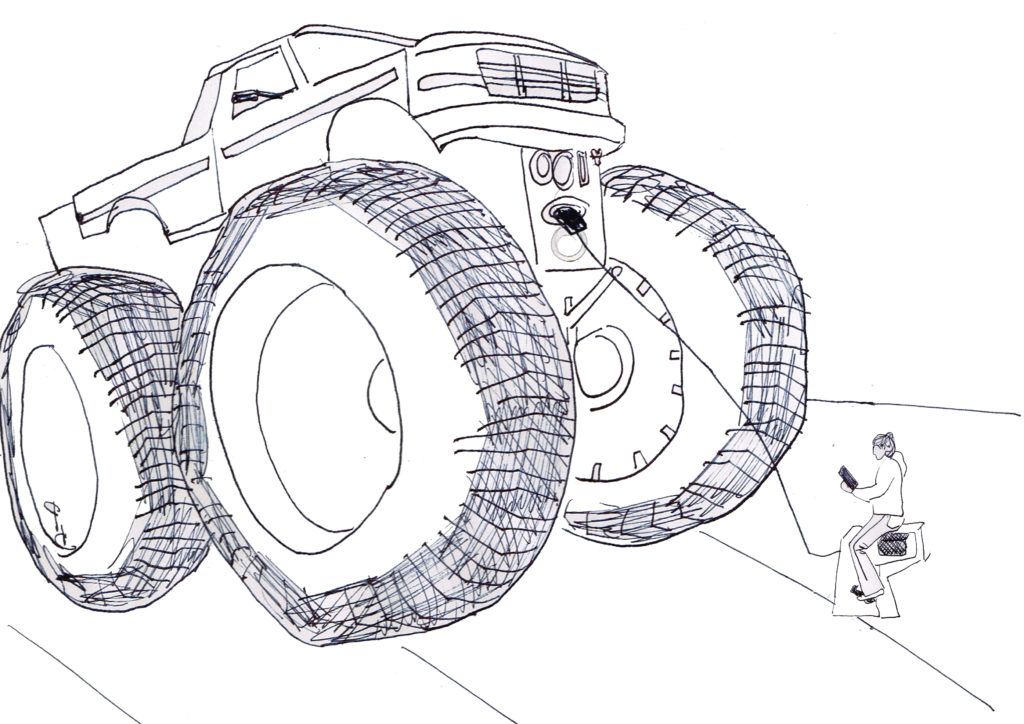
Déjà en 2017, Alain Gras alertait sur la mascarade des « e‑voitures ». A l’aube d’une ère nouvelle où l’on amende sans vergogne les personnes qui utilisent des voitures considérées trop vieilles (et qui seront de toute façon envoyées dans les autres continents), nous avons jugé bon de rappeler cet article qui n’a pas pris une ride.
Elle serait la « solution », celle qui toujours, permettrait de remettre à plus tard l’indispensable réflexion sur notre modèle socio-économique et la nécessité d’en sortir au plus vite. Elle, c’est la voiture électrique qui, au nom de l’écologie, assurerait la transition. Vaste supercherie, la e‑voiture servirait surtout à endormir et distraire les esprits, étant tout sauf écologique, dotée de batteries produites avec des minerais tirés d’une exploitation mondialisée, rechargée par des centrales électriques. On oublierait presque qu’il a fallu les produire pour remplacer les anciennes.
Il me faut revenir sur la question électrique, mais cette fois à propos d’une mode qui fait fureur actuellement : la « e‑voiture de l’avenir ». Devant cette vague de promotion médiatique à l’occasion du salon de l’automobile de Francfort(1), il me semble nécessaire de revenir sur cette grande illusion. Je suis du reste assez étonné que le charismatique dirigeant de PSA-Opel lui-même, Carlos Tavares, ait émis des réserves sur ce choix en ouverture de ce salon…
En premier lieu, on doit se demander pourquoi les gouvernants des pays les plus industrialisés, mais aussi des « émergents » tels la Chine, poussent les constructeurs à s’engager dans cette voie. Les raisons invoquées tiennent évidemment en deux mots : la pollution par les particules et le CO2. L’amélioration de la qualité de l’air figure donc comme un premier argument et a l’avantage d’être aussi un outil de promotion pour les politiques. En effet, l’usage de l’électrique aurait un bénéfice évident dans les villes, où vivent maintenant les trois quarts de la population dans les pays riches ou en voie de le devenir.
Les gouvernants font ainsi preuve à bon compte de leur combat contre le réchauffement climatique. La Scandinavie parade en tête avec sa bonne conscience luthérienne, la Norvège veut abandonner le moteur thermique dès 2025, Volvo en Suède ne produira plus que des moteurs électriques ou hybrides dans trois ans (de fait, la morale est fille de la nécessité car Volvo est maintenant chinois, et la Chine veut avancer vite dans cette voie en raison de la gigantesque pollution urbaine). Pourtant, le problème de la concentration citadine est différent du problème écologique au niveau planétaire. Et sur ce plan, cette nouvelle trajectoire technologique présente un caractère bien moins sympathique, comme on va le voir.
DES BATTERIES DESTRUCTRICES
La réponse classique que les médias prennent pour argent comptant consiste à mettre en avant l’efficacité de ce e‑moteur sur le plan écologique mais aussi mécanique, en négligeant les effets secondaires. La transmission électrique est, en effet, bien plus avantageuse que l’option thermique : 85 à 90% de l’énergie y serait récupérée alors que dans le thermique les rendements ne sont que de 25 à 35%. Toutefois le calcul est biaisé, car il n’est pas tenu compte des pertes en ligne dans l’approvisionnement ni dans le stockage en batterie. En les prenant en considération, le rendement n’est plus que de 65–70% ; ce qui est tout de même, reconnaissons-le, le double du thermique.
Pourtant cette réponse serait insuffisante pour faire le tour de la question si elle ne s’accompagnait pas de la conviction-clé de la modernité : la foi dans un progrès illimité qui devrait résoudre tous les nouveaux problèmes engendrés par ce choix d’une nouvelle trajectoire technologique. Comme ceux-ci, tous considérés comme pouvant être résolus à terme par la technoscience :
- le poids de la batterie, 250kg, dont la charge n’offre encore guère d’autonomie, ce qui explique pourquoi ces véhicules sont surtout utilisés dans les déplacements urbains ;
- la lenteur de la charge : 10 heures en moyenne. À condition de ne pas la laisser se décharger au-dessous d’une limite qui la mettrait hors d’usage ;
- le véhicule électrique ne se révèle supérieur au thermique sur le plan de l’émission de CO2 qu’après 100 000km, en raison du coût énergétique de la fabrication de la batterie et de l’assemblage des divers éléments de haute technologie. Or, c’est le kilométrage moyen des déplacements urbains en 10 ans ; et 10 ans c’est la durée de vie théorique maximum de la batterie.
Pour autant, ce ne sont là que des données mineures, souvent réfutées par les promoteurs de l’électrique, qui concernent essentiellement le consommateur alors que les inconvénients majeurs de la batterie au lithium-ion se trouvent ailleurs.
Ces batteries, bien que considérées comme recyclables, ne le sont que pour un tiers d’entre elles, et exigent deux composants principaux : un métal alcalin relativement abondant pour l’instant, le lithium, situé en des lieux jusque-là protégés de l’exploitation sauvage (en particulier le salar d’Uyuni en Bolivie, le salar del Hombre Muerto en Argentine et le plateau occidental du Garzê au Tibet – ce qui explique aussi l’intérêt de la Chine pour ce pays) et le cobalt extrait dans des conditions épouvantables (20% manuellement, et souvent par des enfants, au fond de trous de plusieurs centaines de mètres) principalement au Congo-Katanga. D’autres composants métalliques conventionnels, tels zinc, aluminium, cuivre, sont présents mais aussi des terres rares, ces nouveaux éléments (principalement lanthanides) dont l’extraction féroce participe davantage à la destruction de l’environnement.
Ainsi, dès le début de l’histoire, il existe un vice de forme écologique car, en plus, le lithium est obtenu par évaporation de l’eau dans une solution : les sels y sont concentrés dans une saumure pour en dégager, par un procédé chimique, le carbonate de lithium. D’énormes quantités sont ainsi perdues. Très acides, elles ne repartent pas dans la nappe phréatique, polluent les sols et provoquent une pénurie d’eau propre, vitale pour les communautés ancestrales de ces régions salées (comme à Gazê, qui se trouve à 3.800 mètres d’altitude).
ROULER AU CHARBON
Un autre danger socio-économique très différent apparaît aussi, celui d’un « effet rebond ». Par exemple, l’amélioration du rendement du moteur thermique a entraîné la création de nouveaux engins, lourds et puissants, tels les SUV et 4x4 urbains, monstres qui n’ont aucune justification autre que d’être des symboles de statut social (ils pèsent de 1,5 à 2,5 tonnes, pour déplacer un humain de 70kg qui en tire un sentiment de puissance). Or, les voitures électriques rentrent dans le même jeu. Ainsi, le fabricant de pointe Tesla a mis en vente un produit de luxe, la Tesla Model S, qui pèse 2,3 tonnes et peut parcourir 500km, mais avec une batterie de 700kg.
Enfin, je reviens sur l’essentiel : le vecteur énergétique. Comment alimenter avec des énergies non polluantes un marché qui serait en 2030 dominé, dans l’ordre, par la Chine, l’Inde et les États-Unis (aujourd’hui premiers), et qui compterait un milliard de véhicules produits d’ici là ? Je rappelle donc cette évidence, qu’il faut sans cesse répéter pour comprendre la vraie nature, quasiment métaphysique, du problème : un vecteur énergétique « transporte » de l’énergie mais il n’est rien en lui-même. À la base, on trouve donc un « potentiel » à transporter, or il y a bien sûr en renouvelable le photovoltaïque et l’éolien ou encore la force hydraulique, mais ces sources, selon les prévisions, donneront des flux insuffisants pour remplacer les centrales thermiques (ou nucléaires) et subvenir aux besoins électriques de base, croissants au niveau mondial (notamment avec l’utilisation toujours plus massive des technologies numériques). Du reste, la part renouvelable, essentiellement électrique au niveau de la production énergétique mondiale, n’augmente pas en pourcentage dans le panier des énergies, malgré tous les beaux discours sur le sujet. Comment alors faire face à l’arrivée massive d’une nouvelle opportunité de consommation ? Le « vecteur » ne fera que transférer la pollution du charbon et du pétrole, ou la chaleur nucléaire, d’un site rural à faible densité humaine vers l’espace urbain à forte densité. La planète n’y gagnera rien.
Nous faire avaler la fable que les voitures seront inoffensives écologiquement grâce au e‑moteur, c’est nous faire croire au Père Noël. Et pourtant les certitudes des adeptes de la religion industrielle sont reprises en chœur par les médias, et personne ne se rend compte que la « reine » électricité, sans ses habits fossiles ou atomiques, est nue. La Chine, hier encore célèbre pour ses embouteillages de vélo, et l’Inde auront bientôt les parcs automobiles les plus importants ; ces pays ont malheureusement repris à leur compte la vision du monde occidentale : la croyance en un lendemain technologique qui chante. La voiture électrique constitue un cas d’école sur les fantasmes du développement écolocroissant-compatible.
Alain Gras, professeur émérite de l’université Paris 1, chroniqueur à La Décroissance. Texte publié dans le journal La Décroissance, octobre 2017.
- NDLR Plus grand salon de l’auto au monde, qui a attiré 810 000 personnes entre le 14 et le 24 septembre 2017, enregistrant toutefois une baisse de 12,9% (www.moniteurautomobile.be).






